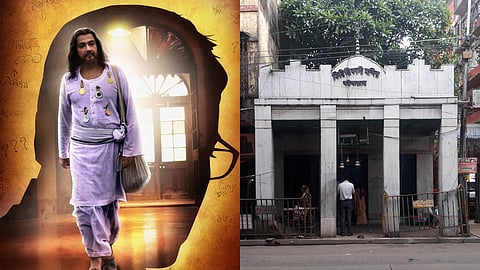
- HOMEGROWN WORLD
- #HGCREATORS
- #HGEXPLORE
- #HGVOICES
- #HGSHOP
- CAREERS
- ABOUT US
- CONTACT US

Chandernagore (present-day Chandannagar, West Bengal) in the 18th-century was a melting pot of many conflicting cultures. An important French settlement on the west bank of the Hooghly, it was the point where French, English, Vaishnava, and Shakta Bengal converged. Hensman Anthony, better known as Anthony "Firinghee", or "Anthony — the Foreigner", was born here in 1786 in an area known as Farashdanga, meaning "French Land" in Bengali. The son of a Portuguese-Christian father and most likely Bengali mother, he became an unlikely icon of Bengal's vernacular kabiyal folk poetry tradition in the 19th century. Although little is known about his life beyond a few of his surviving songs, Anthony Firinghee's story — part fact, part folklore — still echoes in Bengal's popular imagination.
An Unlikely Icon Of The Kabiyal Tradition
In 19th-century Bengal, kabiyali gaan or minstrelsy emerged as a popular vernacular art form outside the parallel streams of Western culture which the European settler-colonisers tried to enforce and the Brahminical traditions which the Hindu orthodoxy espoused. According to Professor Rosinka Chaudhuri, kabiyali gaan was born out of the "urban chaos of cosmopolitan Calcutta in the early nineteenth century" where kabiyal or minstrels/troubadours competed with each other "in the houses of the nouveau-riche for prize money". A rejection of both European modernity and Brahminical tradition, it was considered "vulgarised vernacular public culture" akin to today's rap battles, where poet-singers competed with each other through spontaneous and improvised freestyle verses.
According to prominent Bengali author and academic Arup K. Chatterjee, Anthony's fascination with kabiyali gaan began when a Kabi Sammelan, or conference of poets, was held at his house with the support of his wife Saudamini. A Hindu widow, Saudamini's common-law marriage to Anthony, though rare, was not entirely unprecedented in Chandernagore. A predominantly French and Vaishnava settlement, the local rulers of Chandannagar had abolished the Sati tradition long before the British authorities banned it in 1829. According to Chatterjee, Anthony likely rescued Saudamini during an attempted widow burning, and lived with her in Gereti/Boruti near Chandernagore. By all accounts, Saudamini was a formidable figure in her own right, and inspired Anthony to learn Bengali and start living as a Bengali native would: wearing dhoti and shawl instead of European clothes, and learning to read and write in Bengali. Their unconventional relationship defied both Indian caste laws and European segregation norms.
Whether influenced by Saudamini or fascinated by local festivals, customs, and rituals, Anthony became a devotee of Durga and Kali — the light and dark manifestations of Shakti, or the divine feminine in Hinduism — and soon began singing devotional songs about the deities. Initially, Anthony employed a lyricist named Gorakshananath to write songs for him, but when they fell out because of a dispute over Gorakshanath's fees, he began writing his own songs. A product of Chandernagore's unusually pluralistic cultural landscape, Anthony's songs combined devotional fervour for Durga and Kali with secular humanist undertones, drawing from the syncretic Bengali folk ethos that also inspired Baul singers and mystic poets like Lalan Fakir. In one of his most popular songs, he wrote:
Khrishtey aar Krishney konow tofat naire bhai...
"Brother! There is no difference between Christ and Krishna..."
Anthony's syncretic songs of religious harmony, humanism, and equality for all struck a chord with Bengal's huddled masses. From an outsider ridiculed as a 'Firinghee', he became Anthony "Kabiyal", or "Anthony — the Minstrel". With his prize winnings from kabiyali gaan competitions, Anthony established the idol of Siddheswari Kali inside the Bowbazar Kalibari, and built a new façade for the temple. It is still popularly known as 'Firinghee Kalibari', or 'The Foreigner's Kali Temple' in Kolkata.
A Trader, A Troubadour, & A Tragic Hero
As Anthony's admirers grew, so did his detractors. Hindu Brahmins were particularly against his outward expressions of devotion to Durga and Kali, as well as his relationship with Saudamini, which they saw as an affront to Hindu caste laws and social norms. This is where the history gets murky, but sometime during the peak of Anthony's popularity, when he had gone to compete in a Kabi Sammelan elsewhere, a group of orthodox Hindu men set fire to his house in Gereti/Boruti. According to popular history, the fire not only razed Anthony's house, but also claimed Saudamini's life. Devastated by her death, Anthony isolated himself, left Chandernagore, and spent the final years of his life in Kolkata, near the Bowbazar Kalibari, where he passed away in 1836.
An Enduring Legacy Of Devotion & Defiance
Far from being a passive inheritor of Bengal's syncretic folk cultures, Anthony Firinghee actively took part in shaping the Bengali Renaissance, which followed in his footsteps. Although it would not truly take shape until after his death, the Bengali Renaissance burst forth from the same values of syncretism, inclusive secularism, humanism, rejection of religious rigidity, and acceptance of universal equality and fraternity that Anthony sang about.
Although Anthony's Creole, biracial, nonbinary, even contradictory identity as a Portuguese-Christian by birth and a Bengali Bhakti poet by devotion placed him at the margin of both colonial and caste hierarchies during his life, today he represents a bridge between many cultures in popular Bengali imagination. His story has inspired two award-winning films 'Antony Firingee' (1967) and 'Jaatishwar' (2014), and forces us to reconsider the binaries we often impose on the past: of insider and outsider; of East and West; of purity and hybridity; and of devotion and transgression. Anthony Firinghee represents all of this and something more, something entirely and altogether different — something true to the living, messy, beautiful entanglement that was, and is, Bengal.
